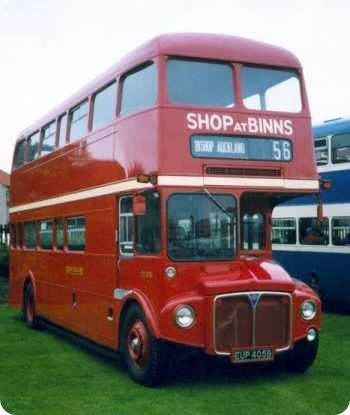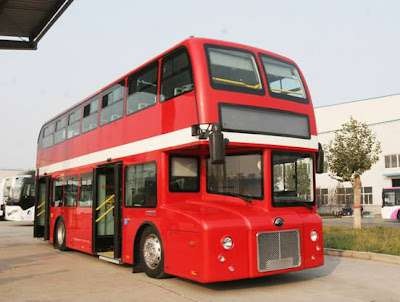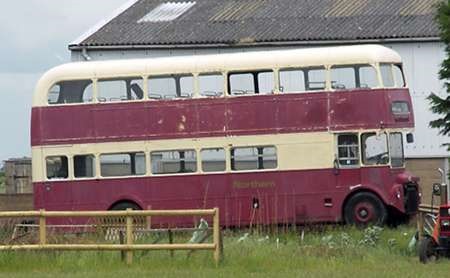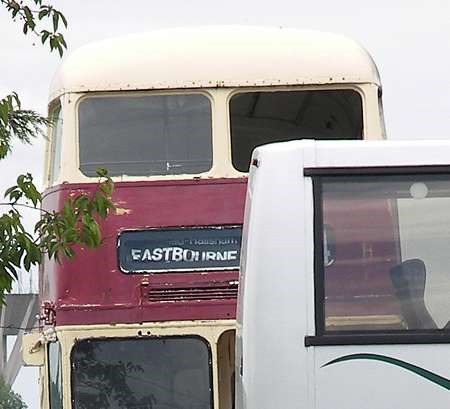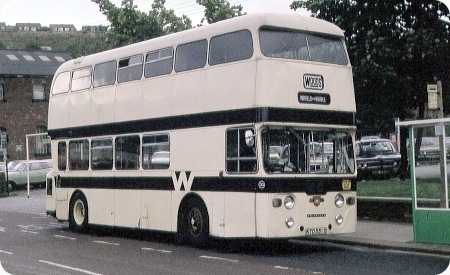Newcastle Corporation – AEC Regent V – 158 – 158 AVK
Newcastle Corporation
1957
AEC Regent V MD3RV
Park Royal L30/28R
In 1956 Newcastle took delivery of 20 AEC Regent V’s with Park Royal H34/28R bodies, they were XVK 137 to XVK 156 and were numbered 137/156. The following year another 20 arrived, registered 157 AVK – 176 AVK and numbered 157/176 – 167/176 were the same as the previous batch, but 157/166 were L30/28R low bridge variants specifically bought for the service 5 to Darras Hall and Ponteland via the Airport, but they did venture onto other routes on occasion. I think some of the high bridge vehicles went to OK Motor Services at Bishop Auckland but I do not know if any of the low bridge type were sold on. I’m not a lover of ‘tin fronts’ and much prefer the exposed radiator type, but the AEC versions seem to be a bit less brutal in appearance than some others. The Regent III standing next to 158 is from the same batch as NVK 341 which has been beautifully restored and is now part of the N.E.B.P.T. Ltd collection.
Photograph and Copy contributed by Ronnie Hoye
A full list of Regent V codes can be seen here.
———
28/05/12 – 08:17
Aah, now I’m feeling all nostalgic! A wonderful photo of two of my all-time favourite classes of Newcastle bus in Morden Street. The Regent V is, of course, the answer to Dave Lazzari’s recent query in the Q&As section. I liked the highbridge version too but I have happy memories of the lowbridge ones on trips out to the airport on service 5 – happy days! The Regent III has to be the ultimate Newcastle Corporation bus, absolutely stunning! I have vivid memories of travelling on them on the Spital Tongues Circle [service 8] and the 1s and 2s. In those days large numbers of buses and trolleybuses were parked in Morden Street mainly between the peaks.
Alan Hall
———
29/05/12 – 17:20
I agree the AEC Regent V tin front was the best looking of the lot. It always gave me the impression of a big smiling face. (Been reading too much Thomas the Tank Engine!). The Park Royal body of this era was beautifully well proportioned and blended with the AEC front so well. A total contrast to the later incarnations using Bridgemaster parts which were the absolute pits! (eg Southampton’s examples).
Philip Halstead
———
30/05/12 – 17:41
Phillip H, you’re being unnecessarily generous by describing the version Southampton had, as the absolute pits. I’ve always regarded them as shoe boxes with holes cut in. It didn’t matter whether the apparition was on a Regent V or on a PD2A, the effect on my eyes was the same.
The Newcastle one illustrated above looks – to me – more like the East Lancs body which Southampton had on most of its Regents, or the standard for the RT. FAR more pleasing to the eye.
Pete Davies
———
31/05/12 – 08:08
As I’ve said before, just about the ugliest body ever built – based on the front-entrance Bridgemaster and the Atlantean design, or lack of it! The highbridge version of the posted design was one of the best ever – also produced by Roe and Crossley. Obviously the RT and RM bodies were classics, but after that the ACV group lost the plot. Only with the AN68 era body did they regain it.
David Oldfield
———
31/05/12 – 20:24
Except for a few examples of absolute boxes on wheels built on Park Royal frames Roe built their superb traditionally styled bodywork on front engined chassis until the demise of these as an option. The thirty foot Daimlers and AEC Regents bought by Leeds in the sixties were true examples of the coach builders art Whereas the front entrance bodies on a small batch of rebodied Tiger chassis owned by Yorkshire Traction were perhaps the very nadir of the Roe out put.
Chris Hough
———
01/06/12 – 07:07
I particularly like this combination of AEC and Park Royal. It’s a very well balanced and good looking vehicle. I can think of Western Welsh and Maidstone and District who took them as well and one or two independents also. Does anyone know of any more?
Chris Barker
———
01/06/12 – 07:09
The traditional composite Roe body, derived from the original Pullmans, has never been bettered. The last were Daimler CVG6s for Northampton in 1968. The Park Royal framed bodies were as a result of Park Royal needing extra capacity as a result of "too much" work – almost certainly the build of Routemasters from 1962 to 1968.
It was, indeed, a small batch of Tiger rebuilds which had the same appalling body as that at Southampton and Swindon. The 1965 Tracky PD3s had a quite pleasant Roe version of the Park Royal body on a number of Sheffield Regent Vs. These looked a little better than the bodies on East Kent Regent Vs and the front engine Bridgemasters.
David Oldfield
———
01/06/12 – 10:05
Further to Chris Barker’s comment, the thirty-foot version of this body looked particularly fine. The first pair – exhibited at the 1956 Commercial Motor Show – were for Cottrell’s of Mitcheldean, and a convertible open-topper for Western Welsh. A further batch were supplied to City of Oxford, after which Park Royal switched to the MCW ‘Orion’-inspired box.
I must say though, that despite their well balanced good looks, these bodies were of fairly lightweight aluminium alloy construction and were disappointingly hard riding and bouncy both on Mk. V and PD2 chassis in my experience.
John Stringer
———
01/06/12 – 15:57
John S..I must confess to no longer being a regular bus user but this week rode on a "58" plate Volvo/Wright double decker and was astonished at how appalling the ride was. Taking a top deck front seat meant I enjoyed a narrow staircase that I nearly fell backwards down because the driver set off with the usual foot to the floor take off then suffered a mix of rolling, swaying and undamped vertical bouncing on the cramped seat. Has the bus industry absolutely no idea whatever about how suspension works? Do they know nothing about adapting spring rates to the vehicle weight, correct damping control, anti roll bars, progressive spring/damper settings to allow a calm ride both when empty or fully loaded? This has been the daily work of the motor industry for decades and is not "magic". Do any PCV builders ever drive a car..ever wonder how to provide a safe and comfortable ride or is it just an industry of dinosaurs who get a batch of lorry chassis parts, bolt them together on a cheap frame and nail a poor quality body on top hoping it will all come out alright? I apologise for being off thread saying this but John’s experience of Mk.V and PD2 chassis reflected exactly mine..just 55 years later!
Richard Leaman
———
01/06/12 – 20:41
I recall Maidstone & District’s Park Royal bodied Regent V’s on the 15 route from Hastings to Eastbourne which as John Stringer says were lightweight in build which made the ride quite lively and the performance very brisk. The beautiful balance of the body dimensions combined with the AEC bonnet design, which I always admired, made this combination one of my favourites the fact that they followed M&D’s batch of ugly Orion bodied PD2’s meant they were doubly appreciated. The AV 470 engine fitted to M&D’s had a very rorty exhaust note especially in a confined street which if the revs were taken to the limit made a waffling sound as the governor cut in.
Richard Leaman’s about the ride and lack of comfort of modern vehicles hit one or two sore spots with me as at 6ft 1in tall space is to say the least limited.
Diesel Dave
———
02/06/12 – 11:51
Four of those Maidstone & District Mk. V’s were surprise temporary additions to the Calderdale J.O.C. fleet in 1972, two highbridge ones operating in Halifax and two lowbridge ones at Todmorden.
By the time I started at Halifax the following year three had already gone, but the last one 362 (VKR 479) was still soldiering on – still in faded M&D livery – but unfortunately was withdrawn just before I passed my PSV.
The AV470 engines left them seriously underpowered for climbing our local mountains, and they were not popular with the drivers – most of whom were not very keen on our own AV590 ones to start with.
Conductors disliked them because of their platform doors, which I believe were not driver-operated probably on safety grounds, and which they had to open and close themselves. Of course according to the rule book it should have been no hardship, because they should have been in attendance on the platform whilst passengers boarded and alighted anyway, but, you know……..! They did make nice exhaust sounds though.
Hebble had four similarly powered short Mk. V’s with Northern Counties bodies new in 1962 which had also really struggled up the same hills and had seemed an ill-advised choice, though they could ‘crack on’ once they got out of Halifax on flatter roads such as on the route to Leeds, but I imagine the M&D ones may have also been higher geared so would have been quite breathless.
John Stringer
———
02/06/12 – 11:52
Interesting comments from both Diesel Dave and John S on the riding qualities of the Orion and later Park Royal bodies. The M&D Regent Vs were an odd choice – a mere 22 of them, (14 highbridge and 8 lowbridge), sandwiched between 70-odd PD2s and the Atlanteans, which Dave will have come across early in their lives, as they were first introduced at Hastings. The company never bought any other AEC double deckers or Park Royal double deck bodies. Maybe they were influenced by neighbours East Kent? Because the Regent Vs were rare, I cannot comment personally on their riding qualities, my experience of them being limited to a couple of hours driving one, from which I can certainly confirm Dave’s memories of the rorty exhaust note.
On the other hand, the Orion bodies on M&D’s Guy Arab IVs rode very satisfactorily, in my view. Could that have been because of the Guy chassis, or simply the terrain of the Medway towns where they operated? (unlikely, I should have thought). Also, although Dave describes the Orion bodied PD2s as ‘ugly’, I always thought the Arab IVs looked businesslike and smart; perhaps that’s because they were essentially urban vehicles. (There’s a posting of one on this site). It wouldn’t do for all of us to agree on everything, any way, would it?
Roy Burke
———
03/06/12 – 07:06
Mention of the Maidstone and District Regent Vs reminds me that they had notices in both saloons explaining that the buses were a temporary measure pending the delivery of new buses.
Philip Carlton
———
03/06/12 – 07:07
Gosh, John, I had no idea that M&D’s Regents found a second life with Calderdale J.O.C. 362 is presumably Calderdale’s number; at M&D, it was DH479. All four of the AECs that went to Calderdale would have been close to the end of their COFs, dating originally from 1956, (and being re-certified for 5 years from 1968), which will be the reason, no doubt, why they didn’t stay long.
Conductor-operated rear doors were pretty much the norm in those days, I think, with provincial operators; the usual practice was for them to be left open in urban areas; conductors busy taking fares – especially upstairs – just wouldn’t have been able to keep opening and closing them at every bus stop. It’s a practice that every Tilling conductor, for example, would have known very well with Bristol Ks and Lodekkas. The draught-saving value of doors over open platforms was primarily felt on those parts of a journey that had longer intervals between stops.
Roy Burke
———
03/06/12 – 11:14
Roy, the M&D Mk. V’s that came to Calderdale J.O.C. were highbridge 361/362 (VKR 472/479) and lowbridge 363/364 (VKR 36/37), the last two looking very similar to the Newcastle one on the photo. They were acquired in January 1972, 361/3/4 being sold in June the same year, but 362 lasting until early 1973.
The lowbridge pair went to Todmorden, whose depot could only accommodate lowbridge buses, and though as AEC’s they stuck out like a sore thumb in this previously Leyland-dominated town, and the growly exhausts rattled a few windows, the M&D livery looked reasonably at home, being not unlike the former T.J.O.C. colours.
362 even went for further service with Ede (Roselyn Coaches) of Par in Cornwall before travelling all the way back up north to be scrapped by a Barnsley breaker in 1979.
364 was acquired for preservation but was scrapped in 1976.
The Geoffrey Hilditch era at Halifax ensured that both local enthusiasts and employees were always kept entertained !
John Stringer
P.S.
When I say ‘both local enthusiasts’ I don’t mean there were only two of us !
———
03/06/12 – 19:38
"Both local enthusiasts"! As you say, John, there were decidedly more than that, and, unlike many other senior figures in the bus industry (then and now), and to his everlasting credit, GGH didn’t regard bus enthusiasm as some kind of severe, untreatable mental aberration. He was always receptive to those who shared a genuine and constructive interest in buses.
Roger Cox
———
04/06/12 – 07:52
The Maidstone & District Mk V’s weren’t the only ones to migrate north. Western Welsh LKG 661 operated for Ideal Service (H. Wray) of Barnsley after disposal by WW, although I imagine Ideal acquired it from one of the Barnsley dealers. I travelled on it once and I wonder if anyone knows what engines the Welsh ones had?
Chris Barker
———
04/06/12 – 17:19
Thank you, John, for the extra information on the ex-M&D Regents. However, I’m left a little bewildered by the fate of 364, (VKR 37, M&D DL37). Regular correspondent Chris Youhill recalls driving a preserved lowbridge Regent many years after 1976, and from memory, I was sure it was DL37. Is it possible this vehicle did actually make it and was not scrapped after all? If not, which of the 8 lowbridge Regents was preserved? I believe one of the highbridge Regents has been preserved, too, but I don’t know which one.
Your comments, and those of Roger, about the accommodating attitude of Mr Hilditch towards enthusiasts rang a mildly ironic note with me. At M&D, it was emphasised to me that the vehicles were the company’s rolling assets, and that my feelings towards any of them should be based purely on operational criteria. Hence my acquired respect for 6LW engined Guy Arabs, which had the best record of any of M&D’s very varied fleet, and the reservations I developed towards their Atlanteans.
I can’t help, Chris, with information on the engines fitted to Western Welsh’s Regent Vs, but no doubt someone more knowledgeable than I will be able to give the answer. I do remember, however, a lot of them had a shallow concave dent in the rear, caused by them bottoming out on the swichback roads of Carmarthenshire.
Roy Burke
———
06/06/12 – 07:42
It’s unusual that Maidstone and District, Newcastle and Western Welsh all bought both highbridge and lowbridge versions of this same combination.
Regarding the engines on the Western Welsh examples, I thought the picture was not straightforward and I was correct. The lowbridge variants were on D3RV chassis and had AV590 engines, whilst the highbridge ones were MD3RV chassis with AV470 engines. Some of them lasted from 1956 to 1972 which was a long time by Western Welsh standards.
678 was one of the last and ended up in France, from where it was recovered for preservation a few years ago. It is now in the custody of the Cardiff Transport Preservation Group.
The most interesting disposal was of 671, which after a brief sojourn at Knowsley Safari Park moved to Armstrong, Westerhope and then passed to Tyneside PTE as their 81 in 1973, being withdrawn in 1974. I’ve not seen pictures of it but it would have looked a lot like Newcastle’s if it got repainted!
David Beilby
———
06/06/12 – 09:44
David, if they were D3RV they had the A218 engine from the Regent III. The Series 2 chassis (e.g. 2D3RA) had the AV590 – the main point of the change to Series 2.
Originally the AV470 "medium weight" Regent V was meant to be the norm. Some operators, however, only wanted heavyweight and insisted on what became the D3RV version. The wet-liner AV590 was not ready, the A218 was available. [Many regret that the AV590 eventually was!]
David Oldfield
———
11/06/12 – 08:34
David Oldfield is quite right that the A218 engine was far superior to the AV590 at least when fitted in the Regent V being quieter and smoother running I drove both types for Eastbourne Corporation in the 1960’s. Regarding my comments about the MCW Orion being ugly I think depends very much on the livery applied, I was recently looking at photos of Orion bodied PD2’s of Halifax fleet and finding myself admiring them in that wonderful green, orange and cream colour scheme, whilst liking M&D’s livery it didn’t seem to suit the Orion as well as it did the Park Royal or Leyland bodies that preceded them.
Diesel Dave
———
14/06/12 – 18:14
A very handsome vehicle. I saw one at Theydon Bois running day Sept 2011.
Bill Hogan
———
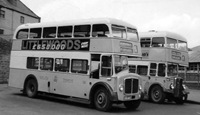 Vehicle reminder shot for this posting
Vehicle reminder shot for this posting
———
08/09/12 – 07:21
Further to comments above, another operator of the 30-foot Park Royal body was A Mayne of Manchester www.flickr.com/ These were LD3RAs, so presumably had the A218 engine. Mayne re-ordered from Park Royal and got this: www.old-bus-photos.co.uk/ Is it any wonder they then went to East Lancs?
Peter Williamson
———
09/09/12 – 07:12
Further to my much earlier posting, here are two views of a rather nice Cottrell’s of Mitcheldean 30 footer.
www.flickr.com/photos/lenmidgham/5266671044/
www.flickr.com/photos/lenmidgham/5266061949/
John Stringer
———
10/09/12 – 07:21
These vehicles pre-date my arrival in Gloucestershire and are interesting for that fact alone. Cottrell’s always needed ‘big boys’ for their services and the 30-footers fitted the bill. A much lamented operator. Thx, John.
Chris Hebbron
Quick links to the - Comments Page - Contact Page - Home Page

